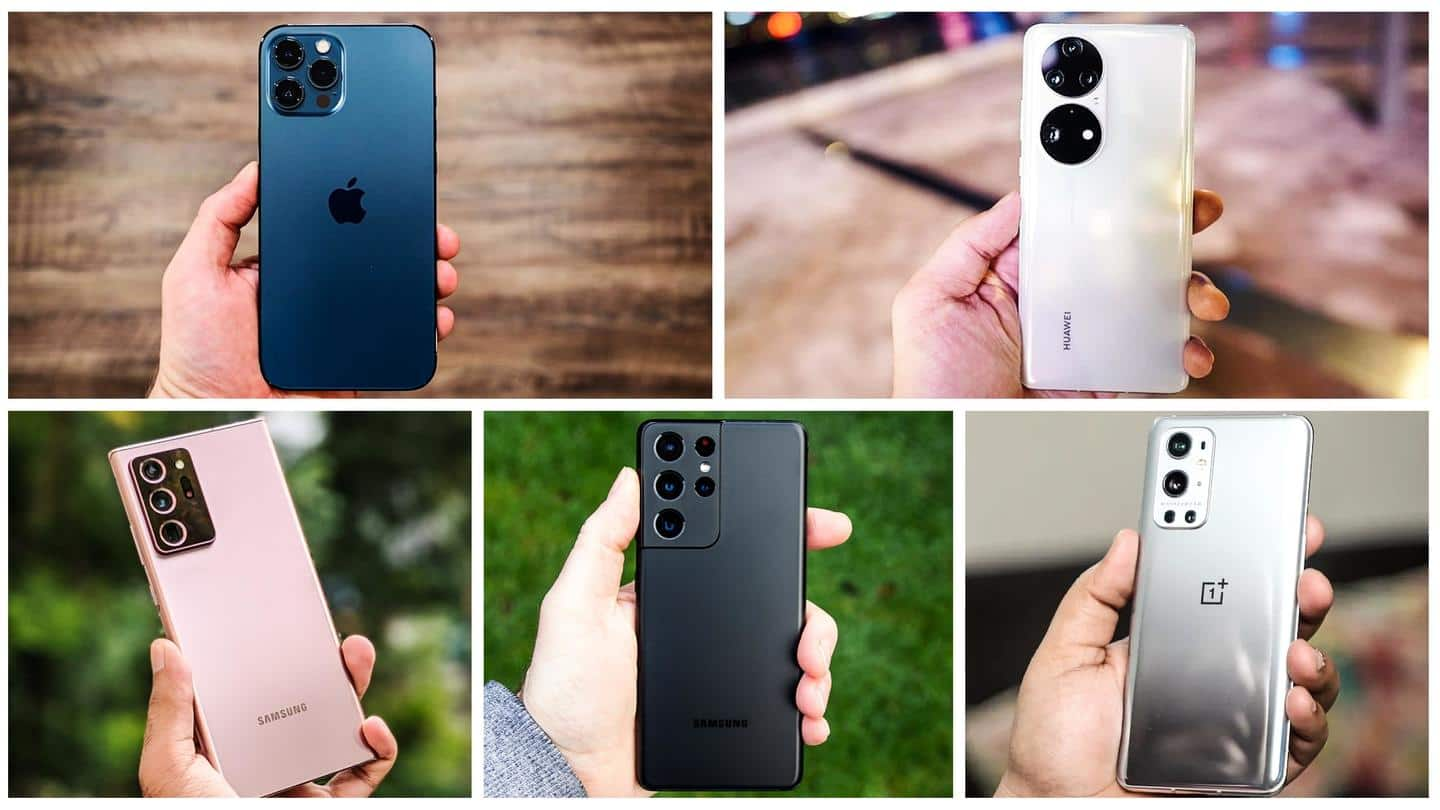
Top 5 smartphones with best displays
What's the story
With the growing trend of binge-watching through nights and constantly browsing through social media, the one important thing that your smartphone requires is a good display.
But how do you determine which one is better than the other? Many benchmarking companies constantly review smartphones and DXOMARK is one among the leading platforms.
Here's the list of the top five smartphones with the best displays.
About DXOMARK
What is DXOMARK and how does it rate displays?
DXOMARK is a French engineering company and a benchmarking platform that assesses different kinds of displays, cameras, audio, and other parameters of products ranging from smartphones to professional cameras.
For display ratings, a number of tests like readability, touch, color, video, motion, and artifacts are performed under controlled lab and real-life situations.
The smartphone is then ranked based on the overall scores achieved.
Phone #1
iPhone 13 Pro Max is reviewed as 'simply stunning'
iPhone 13 Pro Max features a 6.7-inch QHD+ (1284x2778 pixels) XDR OLED screen with a 19.5:9 aspect ratio, up to 1,200-nits of peak brightness, Dolby Vision and HDR10 support, and ProMotion technology with up to 120Hz adaptive refresh rate.
It is said to have excellent readability and a smooth browsing experience. However, in the blue light filter, the screen gets a strong orange cast.
Information
It is powered by an A15 Bionic processor
The iPhone 13 Pro Max has a wide notch with a Face ID setup and a 12MP triple rear camera unit. It draws power from an A15 Bionic chipset and a 4,352mAh battery with 27W wired and 15W MagSafe wireless fast-charging support.
Phone #2
Huawei P50 Pro offers a smooth and accurate touch
The Huawei P50 Pro flaunts a 6.6-inch Full-HD+ (1228x2700 pixels) OLED screen with a 19.8:9 aspect ratio, a 120Hz refresh rate, and a 300Hz touch sampling rate.
The device is touted to have a smooth and accurate touch. It has an appropriate brightness for watching HDR10 videos, however, the dark tones can lack details.
You can also sometimes notice frame drops while starting games.
Information
It offers 50W wireless fast-charging support
The Huawei P50 Pro has a punch-hole design with curved edges, an in-display fingerprint sensor, and a 50MP quad rear camera module. It is powered by a Kirin 9000 chipset and a 4,630mAh battery with 66W wired and 50W wireless fast-charging support.
Phone #3
Samsung Galaxy S21 Ultra has good HDR10 video quality
The Samsung Galaxy S21 Ultra bears a 6.8-inch QHD+ (1440x3200 pixels) Dynamic AMOLED screen with a 120Hz refresh rate, 1,500-nits of peak brightness, and HDR10+ support.
It is reviewed to provide well-adapted brightness and colors for watching HDR10 videos, low frame drops, and a smooth browsing experience.
However, very bright outdoor conditions increase color saturation, and touch points are not accurately detected while gaming.
Information
It offers stylus support
The Samsung Galaxy S21 Ultra has a punch-hole design, curved edges, an IP68 rating, a 108MP quad rear camera unit, and stylus support. It is fueled by an Exynos 2100/Snapdragon 888 chipset and a 5,000mAh battery with 25W wired and 15W wireless fast-charging support.
Phone #4
Samsung Galaxy Note20 Ultra provides well-managed brightness levels
The Samsung Galaxy Note20 Ultra boasts a 6.9-inch QHD+ (1440x3088 pixels) Dynamic AMOLED display with a 120Hz refresh rate and HDR10+ support.
According to DXOMARK, the handset has good brightness levels during the day, display touch is smooth while browsing and skin-tone colors are well-rendered although oversaturated.
However, video rendering suffers owing to contrast issues and touch somewhat lacks accuracy.
Information
It is equipped with a 108MP main camera
The Samsung Galaxy Note20 Ultra has a punch-hole design, sharp corners, an IP68 rating, stylus support, an in-display fingerprint sensor, and a 108MP triple rear camera unit. It is backed by an Exynos 990/Snapdragon 865 5G+ chipset and a 4,500mAh battery with 25W fast-charging support.
Phone #5
OnePlus 9 Pro has accurate color rendering
OnePlus 9 Pro features a 6.7-inch QHD+ (1440x3216 pixels) LTPO AMOLED display with a 120Hz refresh rate, HDR10+ support, and 1,300-nits of peak brightness.
The device is said to have accurate color rendering, smooth browsing touch, and comfortable readability.
However, it does get difficult to distinguish dark details in indoor as well as outdoor conditions and HDR10 video content can be a bit dim.
Information
It supports 65W wired fast-charging
The OnePlus 9 Pro comes with a punch-hole design, curved edges, an IP68 rating, an in-display fingerprint sensor, and a 48MP quad rear camera setup. It draws power from a Snapdragon 888 processor and a 4,500mAh battery with 65W wired and 50W wireless fast-charging support.